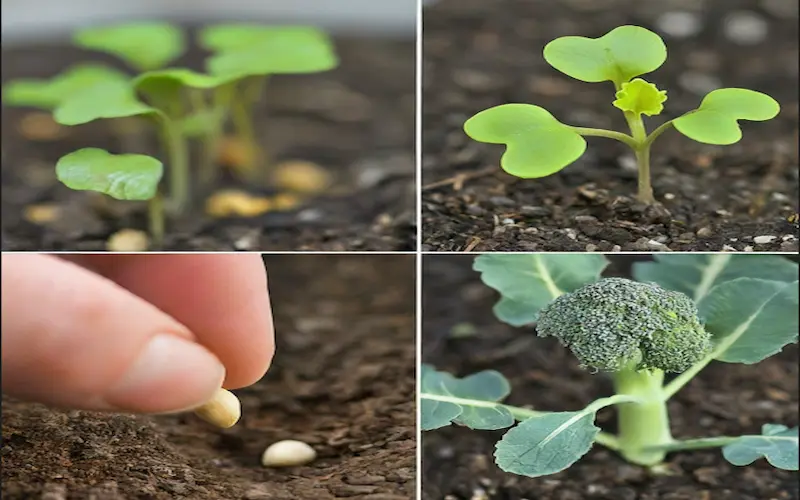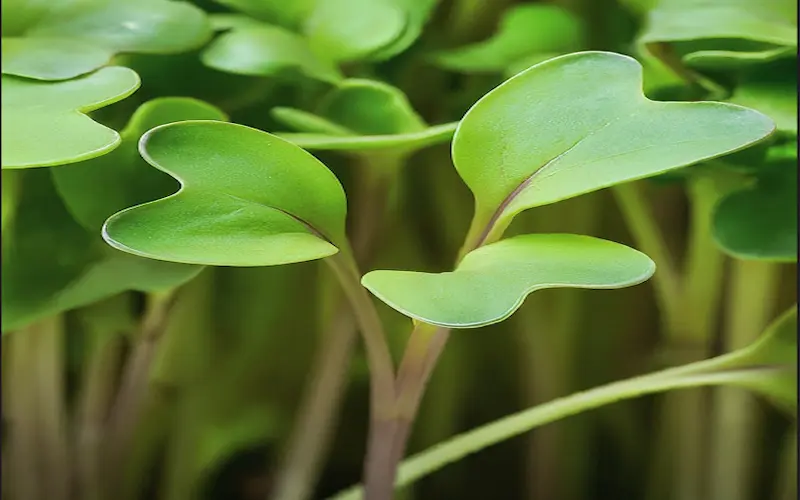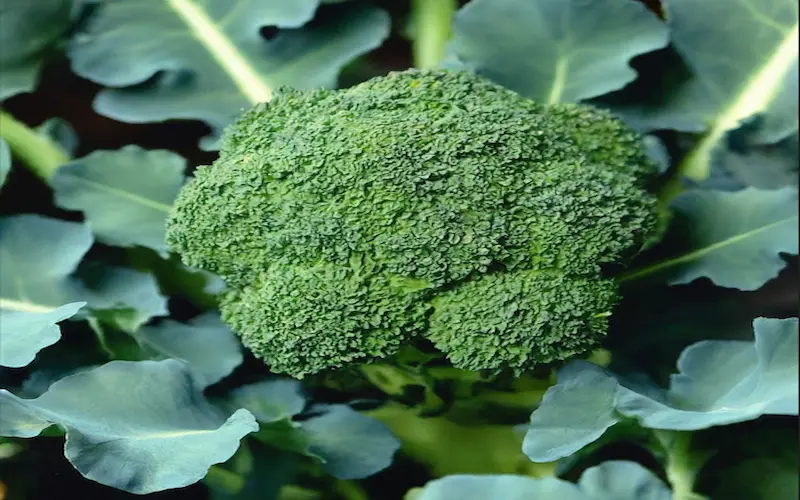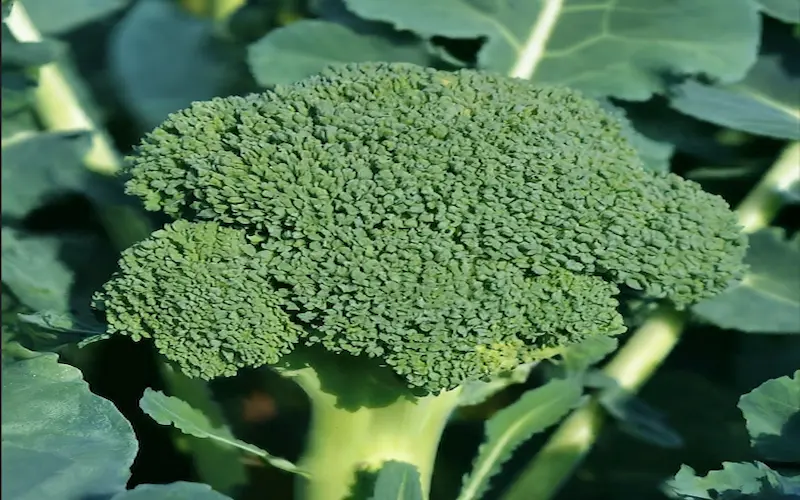Broccoli Growing Stages: A Comprehensive Guide
Published: 17 Apr 2024
Broccoli is a cruciferous vegetable in the Brassicaceae family. It is an edible green plant with a tree-like structure, with thick stems covered in small green leaves. The most common variety is Italian broccoli, also known as Romanesco broccoli. It originated in Italy and is named after the Roman city of Rome. Broccoli is rich in vitamins, minerals, and antioxidants, making it a healthy food choice.
Through this article, I aim to comprehensively explore the Broccoli growing stages, ensuring you are well-equipped to nurture this plant from seed to harvest.

Introduction to growing Broccoli
Growing Broccoli has always been a rewarding experience for me. The journey begins with selecting a suitable variety for my garden’s climate and taste preferences. Broccoli is a cool-season crop that can be grown in containers or on the ground and is generally ready for harvest within 60-90 days after planting.”Broccoli is packed with antioxidants and vitamins. Try adding nutrient-rich greens from our microgreen salad guide to your meals for a fresh twist!”
You will need seeds or seedlings, well-drained soil, and plenty of sunshine and water to grow broccoli. It is important to keep the soil moist but not soggy and protect the plants from pests and diseases. You can enjoy fresh, homegrown broccoli with proper care in just a few weeks.
Broccoli prefers a slightly acidic to neutral soil pH, ranging from 6.0 to 7.0, and requires consistent moisture for optimal growth. I always ensure that my garden bed is well-drained, as standing water can lead to root issues.
It is also very important to select the right area. For it to be fully developed, it needs 6 to 8 hours of direct sunlight daily.

Broccoli Growing Temperature
Broccoli can grow well, around 55-65°F (12-18°C). However, It can be grown in temperatures as low as 38°F (3°C) with proper protection. It’s recommended to avoid extreme temperatures, as they can affect the growth, taste, and quality of the broccoli.
Understanding the different stages of broccoli growth
To successfully grow Broccoli, it’s essential to be familiar with its growing stages. Each stage has its own set of requirements in terms of care, nutrition, and environmental conditions. Broccoli goes through a series of changes from seed to harvest, and as a grower, it’s my responsibility to support the plant at every turn.
The lifecycle of Broccoli is categorized into four main stages: the seedling stage, the vegetative stage, the head formation stage, and the harvesting stage. Each stage presents its challenges and milestones.
This timing is critical because it helps me avoid common issues such as bolting, where the plant flowers go to seed too quickly due to warm temperatures, resulting in a less desirable harvest.

Stage 1: Broccoli Seedlings Stage
The journey begins at the seedling stage. After planting the seeds about 1/4 to 1/2 inch deep in quality soil, germination usually takes 5 to 10 days, depending on the soil temperature. I keep the soil moist but not waterlogged, as the seeds require adequate moisture to sprout.
Once the seeds germinate, providing them with plenty of light is vital. If starting seeds indoors, I often use a grow light to ensure my seedlings don’t become leggy as they stretch toward the light source. Proper lighting helps seedlings grow solid and stocky, crucial for their survival once transplanted outdoors.
After about 4-6 weeks, when the seedlings have developed a few sets of true leaves and are strong enough to handle the outdoor conditions, it’s time for transplanting. Hardening off the seedlings by gradually exposing them to outdoor conditions is a step I never skip to reduce transplant shock.

Stage 2: Vegetative stage
In the vegetative stage, plants focus on growing their leaves and stems. This growth is the foundation for the later development of broccoli heads. During this stage, you should ensure the plants have enough space, nutrients, and water to expand.
Spacing is essential because crowded plants can lead to poor air circulation and increased disease susceptibility. I usually space my broccoli plants about 18 inches apart. This gives them ample room to grow and ensures that each plant receives adequate sunlight.
Feeding is another critical aspect at this stage. Broccoli is a heavy feeder, so I enrich the soil with a balanced fertilizer or compost to provide the necessary nutrients. Regular watering is also essential to maintain steady growth, but I avoid wetting the foliage to reduce the risk of fungal diseases.

Stage 3: Head formation stage
When the plants reach the head formation stage, it’s a clear sign that the time is coming to fruition. The central head of the broccoli plant starts to form, which is a critical time to ensure that the plants are not stressed, as stress can affect head quality.
I continue to monitor for pests, such as aphids and caterpillars, that can damage the developing heads. Organic pest control methods, like introducing beneficial insects or using insecticidal soap, are my preferred means of dealing with these issues.
Consistent watering remains essential during this stage, as any interruption can result in harsh or split heads. I also watch for nutrient deficiencies, particularly nitrogen, and supplement as needed to support the developing heads.

Stage 4: Harvesting stage
The harvesting stage is the most rewarding part of growing Broccoli.
Broccoli Harvesting Time
It’s time to harvest when the heads are firm and compact before the yellow flowers bloom. I use a sharp knife to cut the central head at a slant, about 5 to 6 inches down the stem. This encourages the plant to produce additional side shoots harvested later.
Harvesting in the morning gives the crispest and most flavorful Broccoli. And there’s nothing quite like the taste of Broccoli I’ve nurtured from seed to plate. It’s an actual garden-to-table experience.
Preserving Broccoli
After harvesting, I immediately cool the Broccoli to preserve its freshness and nutritional quality. I can do this by submerging the heads in cold water or placing them in the refrigerator.

Factors Affecting Broccoli Growing Stages
Several factors can influence the success of broccoli growth, and being aware of these has helped me navigate potential pitfalls.
- Weather is a significant factor; Broccoli prefers cooler temperatures, and heat can cause bolting. I try to plant early enough in the spring or late enough in the summer to avoid the heat.
- Soil quality is another essential element. Broccoli benefits from well-draining soil rich in organic matter. I work in compost or aged manure before planting to improve soil structure and fertility.
- Additionally, water availability and pH levels can significantly impact broccoli growth. Consistent watering helps prevent stress while maintaining the correct pH ensures that nutrients are available to the plants.
Tips for successful Broccoli growing at each stage
Having grown Broccoli for years, I’ve gathered many tips to ensure success at each stage.
- It’s crucial to start with good-quality seeds or seedlings. I use sterile soil and containers to prevent disease for the seedling stage. I keep the soil mulched during vegetative to retain moisture and regulate soil temperature.
- I support the plants with stakes at the head formation stage and monitor them closely for pests and diseases. When harvesting, I watch for the perfect timing to ensure the best quality.
- Companion planting has also been beneficial. Planting Broccoli near onions, garlic, or marigolds can help deter pests naturally, reducing the need for chemical interventions.
Common problems and solutions during broccoli growth
Even with meticulous care, issues arise during broccoli growth.
- One common issue is bolting, where the plant goes to seed prematurely due to high temperatures or stress. I plant at the right time to combat this and provide consistent water. Pests like aphids and caterpillars can be managed with organic pesticides or by encouraging natural predators into the garden.
- Ensure proper spacing and air circulation among plants to mitigate diseases such as downy mildew and bacterial head rot. If a disease does strike, I remove and destroy affected plants to prevent the spread.
- Nutrient deficiencies affect Broccoli’s growth. A lack of nitrogen and phosphorus causes leaves to become yellow and purple. Regular soil testing and appropriate fertilization can correct these imbalances.
Related Questions and Answers
Broccoli takes 60 to 90 days to grow from seed to harvest. However, this can vary depending on factors like the specific variety of broccoli, growing conditions, and climate.
The amount of broccoli you get from one plant can vary depending on the variety of broccoli, growing conditions, and care provided. On average, you can expect to harvest multiple heads of broccoli from a single plant. Generally, you might get one main large head and several smaller side shoots after the main head is harvested. This can provide a continual harvest over time from a single plant.
After the main head of broccoli is harvested, many varieties will continue to produce smaller side shoots. These side shoots can be harvested once they reach a usable size, providing an extended harvest period. With proper care and maintenance, you can harvest broccoli side shoots for several weeks after the main head is harvested. Some gardeners report being able to harvest side shoots for up to several months, depending on growing conditions and the variety of broccoli.
Here’s a general timeline for growing broccoli:
- Seed Starting (Week 1-2): Start broccoli seeds indoors about 6-8 weeks before your area’s last expected frost date. Alternatively, you can sow seeds directly into the garden if the soil can be worked early enough.
- Transplanting (Week 5-6): Transplant seedlings outdoors after the danger of frost has passed and the soil has warmed up. Broccoli seedlings can tolerate cool temperatures but not frost.
- Early Growth (Week 7-8): Broccoli plants will continue to grow and develop leaves. Ensure they receive adequate water and sunlight, and consider applying fertilizer if necessary.
- Head Formation (Week 9-12): Depending on the variety, heads typically begin to form around 9-12 weeks after transplanting. Keep an eye on the plants and harvest the main head when it reaches a desirable size and before the individual buds open.
- Side Shoots (Week 12+): After harvesting the main head, many varieties will continue to produce smaller side shoots. These can be harvested as they reach a usable size, extending the harvest period.
- End of Harvest (Varies): The length of the harvest period for side shoots can vary depending on factors like variety, weather, and care. Eventually, the plants will stop producing new shoots, indicating the end of the harvest season.
By following this timeline and providing proper care, you can enjoy a bountiful broccoli harvest from your garden.
Conclusion
Reaching the end of the Broccoli growing stages and achieving a successful harvest is a cause for celebration. The crisp, fresh flavor of homegrown Broccoli is unmatched, and knowing I nurtured these plants from seedlings to maturity is immensely rewarding.
I encourage you to embark on your broccoli-growing journey. With the tips and knowledge in this guide, you’re well-equipped to navigate the stages of growing Broccoli. Gardening is a learning process, bringing new insights and joy each season.

- Be Respectful
- Stay Relevant
- Stay Positive
- True Feedback
- Encourage Discussion
- Avoid Spamming
- No Fake News
- Don't Copy-Paste
- No Personal Attacks



- Be Respectful
- Stay Relevant
- Stay Positive
- True Feedback
- Encourage Discussion
- Avoid Spamming
- No Fake News
- Don't Copy-Paste
- No Personal Attacks



